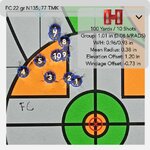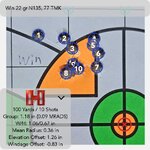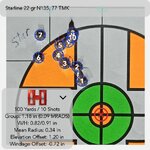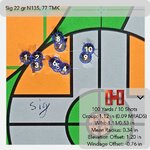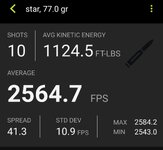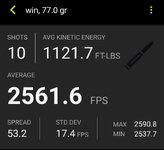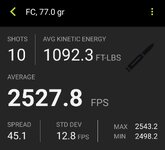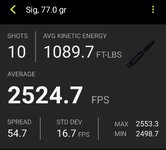Navigation
Install the app
How to install the app on iOS
Follow along with the video below to see how to install our site as a web app on your home screen.
Note: This feature may not be available in some browsers.
More options
Style variation
You are using an out of date browser. It may not display this or other websites correctly.
You should upgrade or use an alternative browser.
You should upgrade or use an alternative browser.
Does brass matter?
- Thread starter Marbles
- Start date
Ignore my dyslexic spelling of weight in Excel.
Correlation coefficient table for all 40 shots.
As case weight goes up, so does velocity
As H2O capacity goes up, velocity goes down
As case weight goes up, H2O capacity goes down

Within headstamps, the relationships are weaker, this could be due to the small sample size.

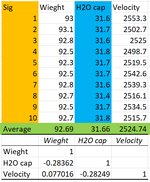
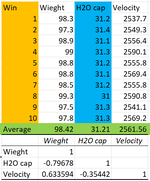

Correlation coefficient table for all 40 shots.
As case weight goes up, so does velocity
As H2O capacity goes up, velocity goes down
As case weight goes up, H2O capacity goes down

Within headstamps, the relationships are weaker, this could be due to the small sample size.




SamsonMan22
WKR
- Joined
- Dec 9, 2018
- Messages
- 462
I care more about brass in the respect to how the longevity is. It just happens that usually the ones that last the longest are some of the more consistent. Most of my reloading these days is for 223, I was using lapua as my only brass until it became impossible to get. I still have some left and have tested it against starline several times with regards to accuracy. In my last testing of it the lapua shot a better “looking” group. 15 of the 30 rounds made one ragged hole just under .9moa and the rest of the 15 outliers stretched the group to just under 1.3moa. The starline shot a group that looked like a small shotgun pattern with only 2 shots that struck pre existing holes. When measured it went 1.4moa. The starline had an es that was 17fps less.
Neither the ES or the group size difference matter at all at even the furthest ranges I will shoot the 223, the starline brass is less than half the price of the lapua which matters a lot. I have not fully tested its longevity vs lapua but it only has to go half as long before it’s a wash. On my larger cartridges I always prefer lapua or alpha just because of how long they last, their consistency is just a bonus especially inside of realistic hunting ranges.
Neither the ES or the group size difference matter at all at even the furthest ranges I will shoot the 223, the starline brass is less than half the price of the lapua which matters a lot. I have not fully tested its longevity vs lapua but it only has to go half as long before it’s a wash. On my larger cartridges I always prefer lapua or alpha just because of how long they last, their consistency is just a bonus especially inside of realistic hunting ranges.
MallardSX2
WKR
- Joined
- Feb 24, 2016
- Messages
- 3,222
Great example of what I have been telling people for years.
If your shooting under 300 yards for deer sized animals , it doesn’t matter. Size em and stuff em.
Thanks for nerding out for us!
If your shooting under 300 yards for deer sized animals , it doesn’t matter. Size em and stuff em.
Thanks for nerding out for us!
SamsonMan22
WKR
- Joined
- Dec 9, 2018
- Messages
- 462
Great example of what I have been telling people for years.
If your shooting under 300 yards for deer sized animals , it doesn’t matter. Size em and stuff em.
Thanks for nerding out for us!
I’m sure the range could be doubled and the same still apply, but I agree.
Jake Larsen
WKR
I’m sure the range could be doubled and the same still apply, but I agree.
I agree 100% with that statement for distances under 300 yards. ES spreads definitely COULD start to matter at 600 yards though, DEPENDING ON factors such as muzzle velocity and BC of your bullet. A little playing with whatever ballistic calculator you’re using will show where the line is for your particulars. If I miss, I want to KNOW it was my mistake.
For example, on my 7mm SAWII, I have a MV of 2730fps with a 165gr TGK. At 600 yards that’s got -73.7” of drop. If I adjust my MV to 2680, allowing for an ES of 50fps (about what most of OPs loads are showing), I get -76.8”. Does that 3” matter? Not on a perfect hold. But field conditions are never perfect, and I like to give myself every advantage I can. Also, in this particular case the bullet I’m shooting has an excellent BC, so it’s fairly forgiving. All depends on the particulars of what you’re using.
Sent from my iPhone using Tapatalk
Last edited:
SamsonMan22
WKR
- Joined
- Dec 9, 2018
- Messages
- 462
Depends on how large of a target you are looking to be in, 600 and under I want to be in a 2moa target to make a fatal hit on deer sized animals. Shooting at a 10 or 12” plate at 600yds with a load that has an es of 70 for 30 rounds is not causing me misses due to elevation unless it’s me being sloppy behind the gun or a ranging error. Wind is my enemy at that distance and where the majority of my missed shots occur, I’m not perfect and can miss a shot high or low but again that’s poor inputs on my part. 3” high or low out of center doesn’t mean a lot to me if I’m staying inside of a target size I want.I agree 100% with that statement for distances under 300 yards. ES spreads definitely start to matter at 600 yards though, DEPENDING ON factors such as muzzle velocity and BC of your bullet. A little playing with whatever ballistic calculator you’re using will show where the line is for your particulars. If I miss, I want to KNOW it was my mistake.
For example, on my 7mm SAWII, I have a MV of 2730fps with a 165gr TGK. At 600 yards that’s got -73.7” of drop. If I adjust my MV to 2680, allowing for an ES of 50fps (about what most of OPs loads are showing), I get -76.8”. Does that 3” matter? Not on a perfect hold. But field conditions are never perfect, and I like to give myself every advantage I can. Also, in this particular case the bullet I’m shooting has an excellent BC, so it’s fairly forgiving. All depends on the particulars of what you’re using.
Sent from my iPhone using Tapatalk
I’m not using a calculator every time out to 600, I’m using the baseline and adding or subtracting mils based on velocity, bc, or certain temp ranges. Inside of 600yds I have not had a need for a calculator other than finding drops initially and after shooting in various temps recording the adjustments I need there.
Not trying to be argumentative here, I used to care a lot more about it because I thought it mattered. Once I started shooting thousands of rounds from 0-600yds a year I saw it really didn’t matter near as much as I thought it did. Just my opinion based off my experience.
Edit* I should have said I agree the ES could have an effect, but in my case the effect isn’t enough to matter. You are correct in some cases it could be an issue but more than likely those are not the typical setups for shooting to those distances in a hunting situation from field positions. Even the 223 isn’t something I would consider ideal for 600yd shooting but it’s serving me well, my hit rate at 600 is just as good or better with it most days as my 6.5cm which has an es of 28 for 30 rounds.
Last edited:
Jake Larsen
WKR
Depends on how large of a target you are looking to be in, 600 and under I want to be in a 2moa target to make a fatal hit on deer sized animals. Shooting at a 10 or 12” plate at 600yds with a load that has an es of 70 for 30 rounds is not causing me misses due to elevation unless it’s me being sloppy behind the gun or a ranging error. Wind is my enemy at that distance and where the majority of my missed shots occur, I’m not perfect and can miss a shot high or low but again that’s poor inputs on my part. 3” high or low out of center doesn’t mean a lot to me if I’m staying inside of a target size I want.
I’m not using a calculator every time out to 600, I’m using the baseline and adding or subtracting mils based on velocity, bc, or certain temp ranges. Inside of 600yds I have not had a need for a calculator other than finding drops initially and after shooting in various temps recording the adjustments I need there.
Not trying to be argumentative here, I used to care a lot more about it because I thought it mattered. Once I started shooting thousands of rounds from 0-600yds a year I saw it really didn’t matter near as much as I thought it did. Just my opinion based off my experience.
Very well explained. I think we’re basically in agreement. Just depends on how you define what “matters”. I shoot quite a bit as well, but all of my shooting is practice for hunting. Ive found that in simulated high pressure scenarios with time constraints and less than ideal field positions, my holds are not going to be great. A marginal but killing hit turns into a bad hit/miss with that 3” variance. But I also agree with you that wind is by far the bigger factor at 600 yards.
However I will say that from 600-1000, everything opens WAY up if your ES numbers aren’t pretty tight.
Edit: An ES of 28 for 30 rounds is really solid!
Sent from my iPhone using Tapatalk
Adam Gibbs
WKR
- Joined
- Aug 28, 2017
- Messages
- 612
I've noticed what you did with Federal brass on all calibers I've loaded it besides .223/5.56mm. Pressure signs well below book max on several different calibers. I don't like it, but in some calibers it's the only brass I have. Not a big deal now that I know. Usually my "max" that I come up with is well below book max.A little back ground. I’ve been reloading for several years but more volume the last 5 or so. My father in law reloaded and never sorted brass and not sure if he ever bought any either, was always picking up range stuff. That’s kinda where I learned to start. So I’ve mostly used the same type of brass and not paid attention to firings etc until the last few years.
Here’s some recent experience. Picked up a tikka 243. All I had was mixed brass from the father in law. Didn’t pay much attention to head stamp. Working up some pressure tests I went from one load not showing pressure to the next 1/2 gr higher blowing a primer and extractor spring and plunger.
Got home and was inspecting cases and noticed there was 3 different head stamps, FC, Winchester and RP. The FC was the one that blew the primer. Decided to weigh a random 5 of each headstamp.
Pic of weights of each along with es listed on right side.

I was surprised at results. Mainly with federal being that much heavier and not as consistent.
Just for giggles I weighed some Alpha brass I have for my 22 creedmoor. Again only 5 random. This batch has been shot 6 times.

To say I was shocked at the consistency of the Alpha was an understatement. I have one bunch of 100 cases of the alpha that have 12 firings and no signs of slowing down. This alpha is basically the only high end brass I’ve used for this long. I did have a gun I bought Lapua brass for but only had 2 firings on that brass and sold the gun.
I bought some Alpha 260 brass I’m going to neck size down for the 243 now.
Sent from my iPhone using Tapatalk
SamsonMan22
WKR
- Joined
- Dec 9, 2018
- Messages
- 462
That’s why I pick the target size I do, aside from rock shooting where I don’t have a lot of control over the exact target size at a given range. If I can stay inside of what I consider a lethal wound size I’m good to go, this is under all conditions both good and bad. Again I’m not a pro and no hit rate is 100%, I have missed close shots on game for various reasons.Very well explained. I think we’re basically in agreement. Just depends on how you define what “matters”. I shoot quite a bit as well, but all of my shooting is practice for hunting. Ive found that in simulated high pressure scenarios with time constraints and less than ideal field positions, my holds are not going to be great. A marginal but killing hit turns into a bad hit/miss with that 3” variance. But I also agree with you that wind is by far the bigger factor at 600 yards.
However I will say that from 600-1000, everything opens WAY up if your ES numbers aren’t pretty tight.
Edit: An ES of 28 for 30 rounds is really solid!
Sent from my iPhone using Tapatalk
I agree after 600 it starts to matter.
The worst part is that load is coming out of a Harrells powder thrower. I dropped it down a half grain a few hundred rounds back and wanted to check the velocity to see how much the drops changed and came up with that as an ES. It’s a good cartridge to work with so I wasn’t super surprised.
Good work! I always beleived the big difference with premium brass is it removes the need to do all the mind numbing brass prep stuff need to do with normal brass. For a lot of my hunting rifles I don’t care, but for some I do. Whether it makes a difference or not I have not done the detailed study you have to prove anything out so appreciate it!
Lou
Lou
Already pulled the Winchester brass for hunting rounds as it is annoying to reload (some of the cases try to pop out of the hand primer and I have to hold them in by hand). The FC brass has tight primer pockets despite having the crimp reamed, and I'm tired of messing with it too. So this will be the last data point.
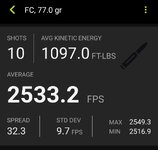
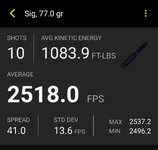
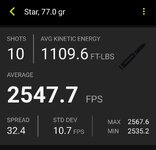
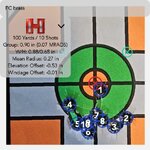

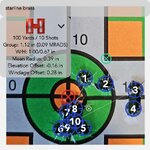






Lawnboi
WKR
Once you figure this out, next is to figure out how to keep a load exactly the same through multiple firings.
Good same lot brass makes that easier down the road.
Getting low ES in 223 is more difficult than it seems with shorter barrels and fast powders.
Good same lot brass makes that easier down the road.
Getting low ES in 223 is more difficult than it seems with shorter barrels and fast powders.
- Banned
- #55
Have you tried varget? CFE 223? Those would be my go to powders. Bullets 69gr SMK 8twist barrel. And you can try 77SMK. BRASS Lapua or Alpha. Out of a bolt gun they should stack at 100 yards.Here is a table with the chronograph data and group data. I have had pretty large SDs and ESs, and now I'm pretty sure it is due to the starline brass. I am predominately using Forms reloading approach, so I'm not chasing perfection, but as I want to shoot long range an SD less than 20 would be nice.
View attachment 674193
(the "Scrubbed starline 9" column is what the starline group would look like without the single high and right shot).
Now, the question is: why is the starline the poor performer on ES and SD? My assumption was that it had to do with case capacity. The Winchester and Starline both had markedly higher velocities than the Sig and FC. Consequently, I predicted the Winchester and Starline cases would have a lower H2O capacity, resulting in increased pressure.
As my resizing die also decaps and expands, I did not want to full length resize, then put spent primers back in. Given that all cases were fired from the same chamber under similar pressures measuring fire formed capacity should be consistent for the sake of comparison.
I numbered the cases, 1-10 for each headstamp. I left the water and cases on the reloading bench during the day to minimize the water changing temperature and the corresponding change in density. All weights were obtained using a draft cover. I weighed the case, recorded the weight, then filled it half full of water, then vigorously tapped the base against the bench while holding the case at an angle to eliminate bubbles, I then filled it until the meniscus protruded from the top, I would then remove the excess water with a knife so I consistently had water flat at the mouth. Then weighed again. When I decamped the cases all primers were soaked, so I think I did a good job avoiding air trapping. Just incase not having trimmed the cases effected capacity, I measured all case lengths. Eyeballing it, I do not see a correlation and do not think this effects the assessment of case capacity.
The full table is not displaying every time, so I broke it up.
View attachment 674362View attachment 674363View attachment 674364View attachment 674366
All cases are numbered, decided to reload them, this time with 22 gr N135. I will shoot in order and compare chronograph data to case capacity. This time I trimmed all brass just to keep neck length consistent. I'll shoot them tomorrow and update. I need to refresh on how to work with correlation in Excel.
Groups from round two with the same brass, this time I loaded 22 gr of N135, rather than 23 gr like last time.
View attachment 674886View attachment 674887View attachment 674888View attachment 674889
Interestingly, the Starline had the best SD this time.
Cannot get Varget locally, can ship it to AK. I'm avoiding powders that are not extruded single base. I was developing loads in -22 and don't want to have to worry if I'm hunting in central Alaska and it is 90 degrees.Have you tried varget? CFE 223? Those would be my go to powders. Bullets 69gr SMK 8twist barrel. And you can try 77SMK. BRASS Lapua or Alpha. Out of a bolt gun they should stack at 100 yards.
Alpha does not make 223 brass that I can tell. Cannot find any Lapua 223 in stock.
- Banned
- #57
Have tried PPU brass? I have a bunch, once fired. If you would like to try some, I can send you some. PM me. It’s not Lapua but not bad.Cannot get Varget locally, can ship it to AK. I'm avoiding powders that are not extruded single base. I was developing loads in -22 and don't want to have to worry if I'm hunting in central Alaska and it is 90 degrees.
Alpha does not make 223 brass that I can tell. Cannot find any Lapua 223 in stock.
Lawnboi
WKR
Cannot get Varget locally, can ship it to AK. I'm avoiding powders that are not extruded single base. I was developing loads in -22 and don't want to have to worry if I'm hunting in central Alaska and it is 90 degrees.
Alpha does not make 223 brass that I can tell. Cannot find any Lapua 223 in stock.
Another brass option, ADI, you can get a case of loaded ADI ammo for 139 right now. It shoots awesome and the brass is decent stuff.
Another thing to consider, I don’t consider a case really formed till the second firing. Getting a consistent size is much easier after the second firing, and that’s normally when I see ES tighten up a little bit. Good factory brass can produce some decent numbers first firing if you know how to make seating smooth.
If you’re not annealing, post firing, the neck starts to harden and it will be hard to keep seating force equal, as some brass will just give more than the others.
In the 45 or so odd years I've been handloading, my experience says yes, variations in brass manufacturer and even lot numbers can be significantly different. Commercial brass is usually (not always) thinner than military brass. Military brass tends to be a bit softer. Internal capacity is smaller with military brass, so be careful if working up to a max load. The main advantage of same brand, lot# brass is consistency. Many match shooters even segregate brass by weight. If you are rolling plinking ammo, I would be too concerned unless you are loading on the hot end. If you want to wring every last bit of accuracy out of your handloads, then keep everything as consistent as possible.
Similar threads
Featured Video
Latest Articles
- TT#64 Josh Boyd Elk Hunting Strategies for Every Season
- Aaron Davidson of Gunwerks
- TT#63 Dirk Durham’s Art of Elk Calling
- BIG Buck Stories with the Dirty Giants Podcast
- TT#62 Brian Barney Hunting Bulls without Calling
- Hoyt Alpha AX-2 SD Review
- Kuiu Kenai vs Outdoor Vitals Vario Hooded Jacket Review
- Hoyt RX-9 Ultra Review
- Hunting Vampire Bucks & Building an Optics Kit
- Darton Sequel ST2 35 Review

